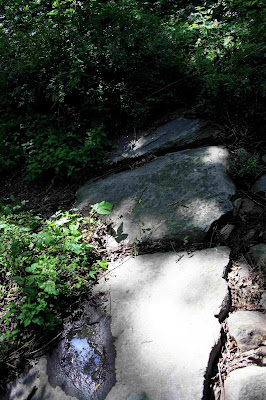By Beth Sullivan
Many of Avalonia’s
trails are on properties that have some significant history. In so
many areas we encounter huge oak trees, old stone walls, fence
posts, and cart paths, all clues about the history of the land.
 |
| A stone span crosses the brook in a quieter season. |
 |
| The brook in flood. |
Historical preserve
Our Pequotsepos
Brook Preserve is one of those. We have had several research
projects done on the property that help explain the history of the
land in that area. Some of this information is on our website for
easy reading here.
The center of
interest on this preserve, and in its history, is the Pequotsepos
Brook that has its origins up the Quoquetaug Hill where waters emerge
and gently flow downhill until they merge more completely at Jerry
Browne Road and Coogan Boulevard. Of course those roads were not
present generations ago. But Jerry Browne Road may have been a
roadway considering some of the older homes and farms along the
lane.
Through the course
of history, the brook needed to be crossed for farm or commerce, and
in these areas bridges were made by positioning huge flat stones over
the stream bed, allowing the water to flow freely and allowing easy,
dry passage. The stone bridges are in existence today, and the old
paths remain as the basis for several pathways collectively
referred to as the Stone Bridges Trail. The entire trail system
contains three brook crossings over stone bridges and offers views of
several other beautiful stone spans .
We have to assume
that there have been big rain storms over the last century that these
bridges were in existence. We know there have been hurricanes and
other destructive storms, but through it all the paths and bridges
remained intact.
Until recently. Is
it a sign of the changing climate that the weather has been wetter or
that the storms in the last months have been more intense rain
events? Maybe it is because of increased development upstream where
the landscape has lost its vegetative cover which used to slow the
rain and absorb the water slowly and gently. Whatever is the cause,
the intense rain storms have caused serious flooding along the brook
and in one area in particular, have caused serious erosion of the
trail. One of the most beautiful and exposed of the stone bridges
has now had the trail on either end of it washed away. Left behind
are exposed tree roots and only the largest of the rocks. The power
of the water washed away soil, gravel and smaller rocks. The
footing is tricky. We need to repair it and the challenge is bigger
than I can manage.
 |
| Near the quarry rocks are exposed and creations have been built. |
 |
| Old trees, stone walls, and fence posts hint of the history in this preserve. |
 |
| These huge stones were placed to cross the brook and allow the water to flow easily. |
Trails Team goes to work
Enter the Avalonia
Trails Team and some hard working Connecticut College Students. We
had the area properly reviewed by our wetland commission chairperson
to make sure we could work in the area. Then the Trails Team leader
came in to assess, and together with others, we tossed around some
ideas. We don’t want to cover up the old stones with a wooden
bridge, but we need to stabilize the footing and still allow the
water to flow through in flood situations.
There is also an old quarry on the property with an abundance of
rocks available in all sizes, and many with lovely flat surfaces.
That is another piece of interesting history. The challenge was
transporting rocks from one place, to another via a very bumpy,
uneven, and often muddy path. On Saturday April 13, ten students from
the Goodwin Niering Center for the Environment at Connecticut College
arrived to experience a day of real stewardship. Of course it had
been raining hard the night before, and the brook itself was once
again in raging flood stage. In a move referred to as adaptive
management, we changed plans. We approached from another entrance,
and for several hours the students moved rocks-lots of rocks. Down a
long and muddy path. Delivered to the site now, they await the next
stage. The Trails Team will work on the next phase: wrangling some
of the bigger rocks out of the quarry and down to the main path to
use as stabilizers and step stones.
This whole process
is likely to take more than just a couple more work parties. In the
end, we hope to have a stabilized trail for walking, as well as a way
to allow flood waters to flow around or through it without washing it
away each time it rains hard.
If you have an
interest in history, if you enjoy team work and want to make a
difference to preserving the trail (or others) and maintaining a
lovely area for many, many hikers, give us a call. The Avalonia website describes the Trails
Team and we can get you in touch with the leader.
Those giant bridge
stones remained intact, but the surrounding area needs a hand. Let
us know if you can offer one. At the very least, come out sometime
and enjoy the trails and consider the history.
 |
| It was a team effort to load and haul the rocks. |
 |
| The team from Connecticut College after several hours of rock moving. |
Photographs by Beth
Sullivan.

No comments:
Post a Comment